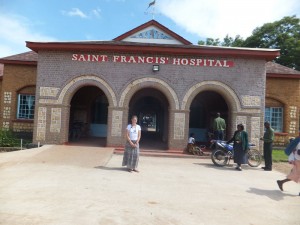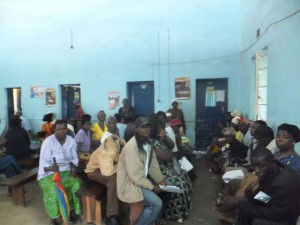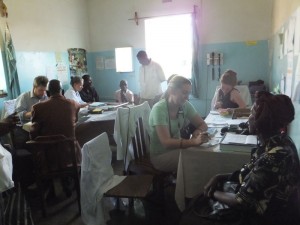This week I headed to St. Francis Hospital in Katete, Zambia.
St Francis is a well-known mission hospital in the Eastern provinces close to the border of Malawi. It is a joint project run by the Anglican and Catholic Church but as far as I can tell it is also run by the Zambian government.
 The hospital is set on huge grounds (it is much bigger than I expected) about 4km from Katete township/village and 90km from the nearest main centre, Chipata. On the hospital grounds there is a church, nursing school, staff mess, and staff houses as well as the clinical buildings.
The hospital is set on huge grounds (it is much bigger than I expected) about 4km from Katete township/village and 90km from the nearest main centre, Chipata. On the hospital grounds there is a church, nursing school, staff mess, and staff houses as well as the clinical buildings.
The hospital has six main wards – male medical, female medical, male surgical, female surgical, obstetric and gynaecology (including labour ward) and the paediatric ward. In terms of doctors, there is a skeleton staff of Zambian doctors who work permanently at the hospital but they are based in gynaecology and obstetrics and one in paediatrics.
Otherwise, there are seven UK based doctors who are volunteering for between six months and one year who cover ALL the other departments!! Most of them are quite young – between 4-7 or so years post-graduation, and want to gain more experience in tropical medicine.
One of the UK doctors is based here for a year as part of her GP training program. What a brilliant idea! I have been told that there are about 300 beds in the hospital – quite big really – but the number of patients can swell to well over 500 as they push beds together and open side rooms with mattresses on the floor.
This is not an unusual occurrence here as the hospital provides care for a huge population and the reputation of St Francis drives patients here from all over.
 So, despite being told it is hard and brutal here, I have decided to spend my time on the paediatric ward, Mbusa. I don’t really know why I came to this decision but I enjoyed my time in paediatrics in Nepal and I do enjoy working with children. The challenges they have warned me about will just have to be faced and I hope to learn from the experience.
So, despite being told it is hard and brutal here, I have decided to spend my time on the paediatric ward, Mbusa. I don’t really know why I came to this decision but I enjoyed my time in paediatrics in Nepal and I do enjoy working with children. The challenges they have warned me about will just have to be faced and I hope to learn from the experience.
The new Mbusa ward was only opened late last year and is probably the most spacious ward. However, it does not mean that we have any new equipment to go with it!
I am working alongside Dr Julie from Scotland, Dr Rebecca from England, and Dr Victor from Zambia who are responsible for around 70 children that are on the ward at any one time. I think it has been quite a shock already to see so many children on the ward – in Greymouth on the West Coast I would rarely see 3 or more!
The ward is also staffed by between 2-3 nurses who I can already see are stretched. Mbusa is split up into three areas – the ICU, main ward and malnutrition. Now you may think great – you have an ICU. It’s not what you would think nor I suppose what I ever thought it would be.
Being in ICU around the hospital pretty much means that you are in the 6-8 beds closest to the nurse’s station and that you may have 2L of oxygen available. That’s it. Seriously that’s it.
 I was surprised and shocked. There are no machines here, no way to monitor patients electronically. It’s just us and clinical awareness. This is going to be a challenge! As you can see in the photo, each bed does have its own mosquito net which is extremely important especially now we are heading into the rainy season and the malaria risk increases significantly.
I was surprised and shocked. There are no machines here, no way to monitor patients electronically. It’s just us and clinical awareness. This is going to be a challenge! As you can see in the photo, each bed does have its own mosquito net which is extremely important especially now we are heading into the rainy season and the malaria risk increases significantly.
When I first walked onto Mbusa, the first thing I noticed was the overwhelming smell. It is difficult to describe but I’m sure you can imagine the smells that come with 70 sick children all accompanied by their family member in the humidity of the rainy season!
Secondly, my first day was really me walking around in a state of shock. These children are so small and look so sick. This is really not going to be an easy job. As we are also so short staffed, we do not have interpreters for the ward and so we must conduct our interviews in the little Chichewa we know and the rest by a variety of charades.
I felt a little lost this week but being forced into speaking the language is great and I feel like I am picking up the key phases (vomit, diarrhoea, ever, seizures, how old etc!) even if I do carry a cheat sheet!!
Ward rounds start at 8am each day (with a 7.30am clinical meeting for the whole staff on Tuesday and Thursday) and we usually finish around 11.30am. Then it is off to the outpatients department to see the walk in patients.
St Francis does not have an emergency room so literally outpatients can vary from those who are unconscious and wheeled into the room, to those with a headache or here for a diabetes review.
 Outpatients is simply broken into 3 clinics – medical (where I am based), surgical and gynaecology. There is no such thing as a GP here so we are basically it which overloads the system I am told. Patients do get free healthcare and medications at St Francis (a wonderful change and quite a relief from what I was dealing with in Nepal) but they MUST go to their local clinic first.
Outpatients is simply broken into 3 clinics – medical (where I am based), surgical and gynaecology. There is no such thing as a GP here so we are basically it which overloads the system I am told. Patients do get free healthcare and medications at St Francis (a wonderful change and quite a relief from what I was dealing with in Nepal) but they MUST go to their local clinic first.
These clinics are staffed by clinical officers (not doctors and not quite nurses) who will review the patient and either treat if they can or refer through to us. While this sounds like a great system, they are really only trained to deal with the basics and send a large proportion of people to us.
Walking into the OPD (outpatients department) my first morning was a shock as well. The waiting crowd was stretched out the door and I was told that sometimes it is impossible to see everyone in the day and many do have to come back (despite living sometimes 7 hours away!).
The clinic room is organised chaos really. The room is incredibly small but can have five doctors, three medical students, five patients (often accompanied) plus two to three interpreters! No such thing as privacy here to be honest.
The patients are crowded around the door desperate to get in to see us and it really is every man for themselves. Unfortunately there is no triage system and so some of the sickest patients can be at the back of the queue. If there is no one there to fight to get them through the door, people will go around them and we don’t see them. Literally people can be dying just outside our door and we won’t know.
This week I have been thrown in the deep end and have been seeing patients both alongside the doctors and by myself. It’s quite scary to see patients myself but at the same time I feel ready for the challenge.
Already this week I have seen a broken maxilla, Kaposi’s sarcoma, TB, HIV, seizures, severe hypoglycaemia, nephroblastomas and so many more. I have even helped to tell a young man that he has HIV which is devastating news accepted relatively easily here. I just can’t believe what I have seen already. Both the hospital resources, the sheer number of patients and the variety of medical conditions. What does the next four weeks have in store me?!

No comments yet.
Leave a comment